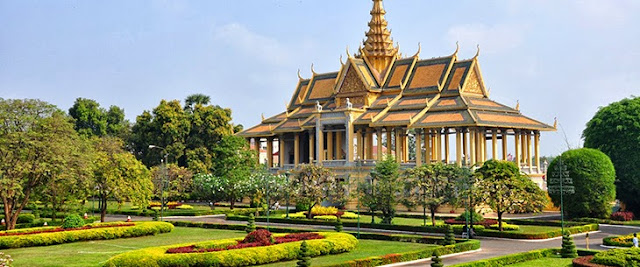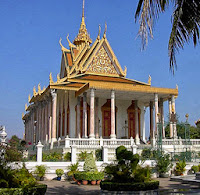- Prasat Tevea Vinichhay (the throne hall): The hall where Kings and Queens are crowned.
- Prasat Khemarin: The hall where the monarchs live.
- Prasat Samran Phirum: The hall where the monarchs ride the Royal Elephant.
- Hor Baku or Hor Preah Khan: The hall where the throne objects and accessories are kept.
- Chan Chhaya: The hall where Royal Dance performers train. In front of the Chan Chhaya, there is a platform where the King can hold audiences with his subjects and all levels of officials.
Wat Preah Keo Morakot (The Silver Pagoda)
Wat Preah Keo Morakot is located in the southern portion of the Royal Palace complex. The pagoda was formerly known as Wat Uborsoth Rotannaram because it is where the King worshiped, prayed and practiced every Buddhist Silas Day. In addition, the royal family and officials also held Buddist ceremonies there.
This pagoda has no monks. However, his Majesty King Norodom Sihanouk lived there for one year when he entered the monkhood on July 31, 1947. Because the pagoda has no monks, visitor usually refer to it as Preah Vihear Preah Keo Morakot. When the King celebrates Buddhist ceremonies, monks from other pagoda such as Wat Unaloam and Wat Botumvattey are invited to attend the ceremonies.
Preah Vihear Preah Keo Morakot was built between 1892 and 1902 during the regin of King Norodom, but at that time it was constructed of wood and brick. Its design is based on Cambodian architectural style. The Banhchos Khan Seima ceremony was held on Feb 5, 1903.
The temple was later damaged and Queen Kosamak Nearyrath asked that it be repaired. Under the direction of her son Samdach Preah Norodom Sihanouk, who at that time was the head of state, the old temple was dismantied and reconstructed in 1962 on the same site with reinforced concrete. The floor was laid with silver files, and the columns were covered with glass stone imported from Italy. The architecture, however, remained the same.
This temple is called Preah Vihea Preah Kep Morakot because the main Buddha statue is made of priceless emerald, which Cambodians call Keo Morakot. Westerners, however, prefer to call the temple the Silver Pagoda because of the 5,329 genuine silver tiles that cover floor.
There are 1,650 art object housed in this temple. Most of them are Buddha figures. They are made of gold, silver bronze and other valuable materials. Some are decorated with diamonds. They are gifts from King, the royal family, dignitaries and other people who worship at Preah Vihear Preah Keo Morakot, where they pray for peace and prosperity for happiness and for preservation of Cambodian cultural heritage for the generation.
In front of the throne, sits a Buddha statue made of gold weighing 90 kilograms (about 200 pounds) and decorated with 2,086 diamonds. The biggest diamond is on the crown. It is 25 millimeters. This statue was commissioned in 1904 by king Sisowath, following the suggestion of King Norodom. King Norodom said, after his body was cremated the gold casket should be melted to make a Buddha statue representing Preah Srie Araymetrey. This Buddha statue is named Preah Chin Raingsei Rachik Norodom.
Objects of particular interest in the Preah Vihear Preah Keo Morakot include:
- The Preah Keo Morakot, the Emerald Buddha which sits atop a throne in the center of the temple.
- There is a small glass cabinet that contains what Buddhists believe are ashes of the Buddha. The ashes were brought from Sri Lanka in 1956 by Sam Dech Head Monk Lvea Em, who stayed in Wat Lang Ka in Phnom Penh.
- In a nearby cabinet sits a gold Buddha figure offered by Queen Kosamak Mearyrath, mother of King Norodom Sihanouk in 1969. This Buddha figure is protected by naga. It represents when the Buddha stayed at the Muchalonti Pond.
- Objects in other cabinets are the keepsakes and decorated objects for royal and Buddhist ceremonies.
The temple is surrounded by a lofty gallery. On the wall of the gallery, there are traditional paintings of the entire Ream Ke epic. These paintings were done by 40 Cambodian artists between 903 and 1904 under the direction of Oknha Tep Nimit. The Ream Ke paintings is 642 meters long and 3 meters high. It starts from the south of the eastern gallery and winds its way around the gallery. This means that visitors must walk in a circle to see the entire story.
The ancient epic Ream Ke along the gallery shows a unique scene not copied completely from Indian Ramayana. Because some plots of Cambodian Ream Ke are so mysterious, visitors must look at painting carefully. Visitors who are familiar with Indian Ramayana will understand the Cambodian Ream Ke easily, even though the two versions are different. Some themes are also depicted by La Khon Khaol or depicted in Sbek Thom and other sculpted figures. Astrologers also use the story to tell fortunes.
Weather, structural damage and destruction by visitors over the years have caused the painting to deteriorate. In 1985, the Cambodian government was cooperating with the government of Poland to restore, protect and maintain the painting. The venture lasted only five years, however, because the budget was terminated. Today the Cambodian government is looking for ways to conserve, restore and maintain this cultural heritage.
Monks from Phnom Penh and other provinces once studied the Pali language in classes that were held along the gallery before the Pali school was opened in Phnom Penh on December 16, 1930.
In front of Preah Vihear Preah Keo Morakot are two stupas and a status under the roof. The south stupa holds the cremains of King Ang Duong, the great-great grandfather of King Sihanouk. The north stupa holds the cremains of King Norodom, the great grandfather of King Sihanouk. Both stupas were dedicated on March 13, 1908.
The statue of King Norodom riding a horse was created in 1875. It was the keepsake of the French King Napoleon III. It was kept in front of Preah Vihear Preah Keo Morakot in 1892, but at that time there was no roof. During King Sihanouk crusade to win independence from France, he prayed in front of statue. After Cambodia won its independence on Nov 11, 1953, King Sihanouk had the roof built in honor of King Norodom. South of Preah Vihear Preah Keo Morakot beside Thamma Hall, a place for praying and the stupa of King Sihanouk father, King Norodom Soramith which was built in 1960, visitors will find.



